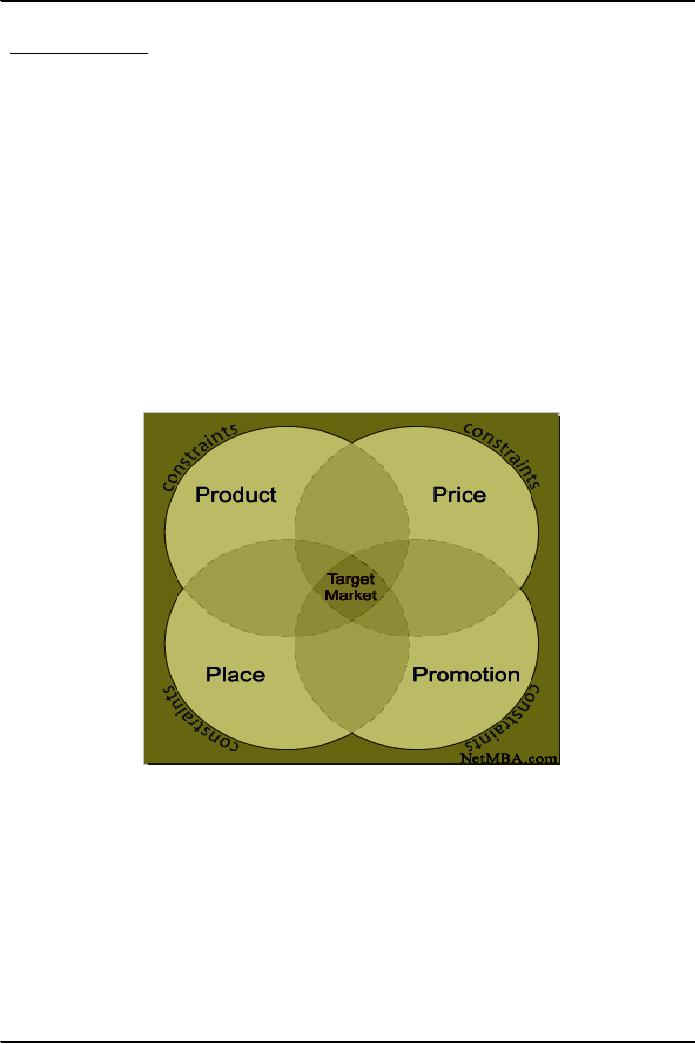 |

Strategic
Management MGT603
VU
Lesson
37
MARKET
SEGMENTATION
Learning
objectives
The
main objective of this chapter to enable
to students about concern marketing
issue such marketing
segmentation,
marketing mix and product
positioning relating to strategy
implementation.
Marketing
Mix
Marketing
decisions generally fall
into the following four
controllable categories:
�
Product
�
Price
�
Place
(distribution)
�
Promotion
The
term "marketing mix" became popularized
after Neil H. Borden published his 1964
article, The
Concept
of
the Marketing Mix. Borden
began using the term in his
teaching in the late 1940's after
James Culliton had
described
the marketing manager as a "mixer of ingredients".
The ingredients in Borden's marketing
mix
included
product planning, pricing, branding,
distribution channels, personal
selling, advertising,
promotions,
packaging, display, servicing, physical
handling, and fact finding
and analysis. E.
Jerome
McCarthy
later grouped these ingredients into the
four categories that today
are known as the 4 P's
of
marketing,
depicted below:
The
Marketing Mix
These
four P's are the parameters
that the marketing manager can
control, subject to the internal
and
external
constraints of the marketing environment.
The goal is to make
decisions that center the
four P's
on
the customers in the target market in
order to create perceived
value and generate a
positive response.
Product
Decisions
The
term "product" refers to tangible,
physical products as well as services.
Here are some examples of
the
product
decisions to be made:
�
Brand
name
�
Functionality
�
Styling
�
Quality
�
Safety
�
Packaging
132

Strategic
Management MGT603
VU
�
Repairs
and Support
�
Warranty
�
Accessories
and services
Price
Decisions
Some
examples of pricing decisions to be
made include:
�
Pricing
strategy (skim, penetration,
etc.)
�
Suggested
retail price
�
Volume
discounts and wholesale
pricing
�
Cash
and early payment
discounts
�
Seasonal
pricing
�
Bundling
�
Price
flexibility
�
Price
discrimination
Distribution
(Place) Decisions
Distribution
is about getting the products to the customer. Some
examples of distribution
decisions
include:
�
Distribution
channels
�
Market
coverage (inclusive, selective, or
exclusive distribution)
�
Specific
channel members
�
Inventory
management
�
Warehousing
�
Distribution
centers
�
Order
processing
�
Transportation
�
Reverse
logistics
Promotion
Decisions
In
the context of the marketing mix,
promotion represents the various
aspects of marketing
communication,
that is, the communication of information
about the product with the goal of
generating a
positive
customer response. Marketing
communication decisions include:
�
Promotional
strategy (push, pull,
etc.)
�
Advertising
�
Personal
selling & sales force
�
Sales
promotions
�
Public
relations & publicity
�
Marketing
communications budget
Product
Positioning
"It
simply means Positioning is
how a product appears in
relation to other products in the
market"
After
segmenting markets so that the
firm can target particular
customer groups, the next
step is to find
out
what customers want and expect.
This takes analysis and
research. A severe mistake is to
assume the
firm
knows what customers want and
expect. Countless research
studies reveal large
differences between
how
customers define service and
rank the importance of different service
activities and how
producers
view
services. Many firms have
become successful by filling the
gap between what customers
and
producers
see as good service. What the
customer believes is good
service is paramount, not what the
producer
believes service should
be.
Product
positioning strategy
The
ability to spot a positioning
opportunity is a sure test of a
person's marketing ability.
Successful
positioning
strategies are usually
rooted in a product's sustainable
competitive advantage. The
most
common
basis for constructing a product
positioning strategy
are:
�
Positioning
on specific product features
133

Strategic
Management MGT603
VU
�
Positioning
on specific benefits, needs, or
solutions
�
Positioning
on specific use categories
�
Positioning
on specific usage occasions
�
Positioning
on a reason to choose an offering
over the competition
�
Positioning
against another product
�
Positioning
through product class
dissociation
�
Positioning
by cultural symbols
The
following steps are required in
product positioning:
1.
Select key criteria that
effectively differentiate products or
services in the industry.
2.
Diagram a two-dimensional product-positioning map
with specified criteria on each
axis.
3.
Plot major competitors' products or services in the
resultant four-quadrant
matrix.
4.
Identify areas in the positioning
map where the company's products or
services could be most
competitive
in the given target market. Look
for vacant areas
(niches).
5.
Develop a marketing plan to position the
company's products or services
appropriately.
134
Table of Contents:
- NATURE OF STRATEGIC MANAGEMENT:Interpretation, Strategy evaluation
- KEY TERMS IN STRATEGIC MANAGEMENT:Adapting to change, Mission Statements
- INTERNAL FACTORS & LONG TERM GOALS:Strategies, Annual Objectives
- BENEFITS OF STRATEGIC MANAGEMENT:Non- financial Benefits, Nature of global competition
- COMPREHENSIVE STRATEGIC MODEL:Mission statement, Narrow Mission:
- CHARACTERISTICS OF A MISSION STATEMENT:A Declaration of Attitude
- EXTERNAL ASSESSMENT:The Nature of an External Audit, Economic Forces
- KEY EXTERNAL FACTORS:Economic Forces, Trends for the 2000’s USA
- EXTERNAL ASSESSMENT (KEY EXTERNAL FACTORS):Political, Governmental, and Legal Forces
- TECHNOLOGICAL FORCES:Technology-based issues
- INDUSTRY ANALYSIS:Global challenge, The Competitive Profile Matrix (CPM)
- IFE MATRIX:The Internal Factor Evaluation (IFE) Matrix, Internal Audit
- FUNCTIONS OF MANAGEMENT:Planning, Organizing, Motivating, Staffing
- FUNCTIONS OF MANAGEMENT:Customer Analysis, Product and Service Planning, Pricing
- INTERNAL ASSESSMENT (FINANCE/ACCOUNTING):Basic Types of Financial Ratios
- ANALYTICAL TOOLS:Research and Development, The functional support role
- THE INTERNAL FACTOR EVALUATION (IFE) MATRIX:Explanation
- TYPES OF STRATEGIES:The Nature of Long-Term Objectives, Integration Strategies
- TYPES OF STRATEGIES:Horizontal Integration, Michael Porter’s Generic Strategies
- TYPES OF STRATEGIES:Intensive Strategies, Market Development, Product Development
- TYPES OF STRATEGIES:Diversification Strategies, Conglomerate Diversification
- TYPES OF STRATEGIES:Guidelines for Divestiture, Guidelines for Liquidation
- STRATEGY-FORMULATION FRAMEWORK:A Comprehensive Strategy-Formulation Framework
- THREATS-OPPORTUNITIES-WEAKNESSES-STRENGTHS (TOWS) MATRIX:WT Strategies
- THE STRATEGIC POSITION AND ACTION EVALUATION (SPACE) MATRIX
- THE STRATEGIC POSITION AND ACTION EVALUATION (SPACE) MATRIX
- BOSTON CONSULTING GROUP (BCG) MATRIX:Cash cows, Question marks
- BOSTON CONSULTING GROUP (BCG) MATRIX:Steps for the development of IE matrix
- GRAND STRATEGY MATRIX:RAPID MARKET GROWTH, SLOW MARKET GROWTH
- GRAND STRATEGY MATRIX:Preparation of matrix, Key External Factors
- THE NATURE OF STRATEGY IMPLEMENTATION:Management Perspectives, The SMART criteria
- RESOURCE ALLOCATION
- ORGANIZATIONAL STRUCTURE:Divisional Structure, The Matrix Structure
- RESTRUCTURING:Characteristics, Results, Reengineering
- PRODUCTION/OPERATIONS CONCERNS WHEN IMPLEMENTING STRATEGIES:Philosophy
- MARKET SEGMENTATION:Demographic Segmentation, Behavioralistic Segmentation
- MARKET SEGMENTATION:Product Decisions, Distribution (Place) Decisions, Product Positioning
- FINANCE/ACCOUNTING ISSUES:DEBIT, USES OF PRO FORMA STATEMENTS
- RESEARCH AND DEVELOPMENT ISSUES
- STRATEGY REVIEW, EVALUATION AND CONTROL:Evaluation, The threat of new entrants
- PORTER SUPPLY CHAIN MODEL:The activities of the Value Chain, Support activities
- STRATEGY EVALUATION:Consistency, The process of evaluating Strategies
- REVIEWING BASES OF STRATEGY:Measuring Organizational Performance
- MEASURING ORGANIZATIONAL PERFORMANCE
- CHARACTERISTICS OF AN EFFECTIVE EVALUATION SYSTEM:Contingency Planning